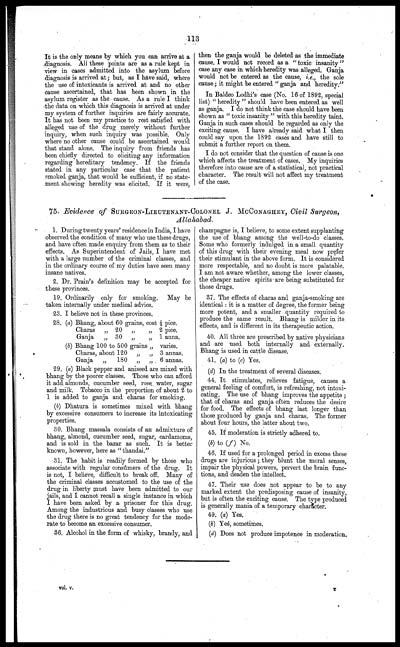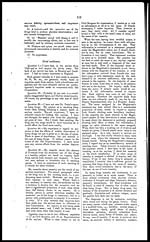Medicine - Drugs > Report of the Indian Hemp Drugs Commission, 1894-1895 > Volume V
(133) Page 113
Download files
Individual page:
Thumbnail gallery: Grid view | List view

113
It is the only means by which you can arrive at a
diagnosis. All these points are as a rule kept in
view in cases admitted into the asylum before
diagnosis is arrived at; but, as I have said, where
the use of intoxicants is arrived at and no other
cause ascertained, that has been shown in the
asylum register as the cause. As a rule I think
the data on which this diagnosis is arrived at under
my system of further inquiries are fairly accurate.
It has not been my practice to rest satisfied with
alleged use of the drug merely without further
inquiry, when such inquiry was possible. Only
where no other cause could be ascertained would
that stand alone. The inquiry from friends has
been chiefly directed to eliciting any information
regarding hereditary tendency. If the friends
stated in any particular case that the patient
smoked ganja, that would be sufficient, if no state-
ment showing heredity was elicited. If it were,
then the ganja would be deleted as the immediate
cause. I would not record as a " toxic insanity"
case any case in which heredity was alleged. Ganja
would not be entered as the cause, i.e., the sole
cause; it might be entered " ganja and heredity."
In Baldeo Lodhi's case (No. 16 of 1892, special
list) " heredity " should have been entered as well
as ganja. I do not think the case should have been
shown as " toxic insanity " with this heredity taint.
Ganja in such cases should be regarded as only the
exciting cause. I have already said what I then
could say upon the 1892 cases and have still to
submit a further report on them.
I do not consider that the question of cause is one
which affects the treatment of cases. My inquiries
therefore into cause are of a statistical, not practical
character. The result will not affect my treatment
of the case.
75. Evidence of SURGEON-LIEUTENANT-COLONEL J. MCCONAGHEY, Civil Surgeon,
Allahabad.
1. During twenty years' residence in India, I have
observed the condition of many who use these drugs,
and have often made enquiry from them as to their
effects. As Superintendent of Jails, I have met
with a large number of the criminal classes, and
in the ordinary course of my duties have seen many
insane natives.
2. Dr. Prain's definition may be accepted for
these provinces.
19. Ordinarily only for smoking. May be
taken internally under medical advice.
23. I believe not in these provinces.
|
28. |
(a) Bhang, about 60 grains, cost |
½ pice. |
|||
|
Charas |
„ 20 |
„ |
„ |
2 pice. |
|
|
Ganja |
„ 30 |
„ |
„ |
1 anna. |
|
|
(b) Bhang 100 to 500 grains „ |
varies. |
||||
|
Charas, |
about 120 |
„ |
„ |
3 annas. |
|
|
Ganja |
„ 180 |
„ |
„ |
6 annas. |
|
29. (a) Black pepper and aniseed are mixed with
bhang by the poorer classes. Those who can afford
it add almonds, cucumber seed, rose water, sugar
and milk. Tobacco in the proportion of about 2 to
1 is added to ganja and charas for smoking.
(b) Dhatura is sometimes mixed with bhang
by excessive consumers to increase its intoxicating
properties.
30. Bhang massala consists of an admixture of
bhang, almond, cucumber seed, sugar, cardamoms,
and is sold in the bazar as such. It is better
known, however, here as "thandai."
31. The habit is readily formed by those who
associate with regular consumers of the drug. It
is not, I believe, difficult to break off. Many of
the criminal classes accustomed to the use of the
drug in liberty must have been admitted to our
jails, and I cannot recall a single instance in which
I have been asked by a prisoner for this drug.
Among the industrious and busy classes who use
the drug there is no great tendency for the mode-
rate to become an excessive consumer.
36. Alcohol in the form of whisky, brandy, and
champagne is, I believe, to some extent supplanting
the use of bhang among the well-to-do classes.
Some who formerly indulged in a small quantity
of this drug with their evening meal now prefer
their stimulant in the above form. It is considered
more respectable, and no doubt is more palatable.
I am not aware whether, among the lower classes,
the cheaper native spirits are being substituted for
those drugs.
37. The effects of charas and ganja-smoking are
identical : it is a matter of degree, the former being
more potent, and a smaller quantity required to
produce the same result. Bhang is milder in its
effects, and is different in its therapeutic action.
40. All three are prescribed by native physicians
and are used both internally and externally.
Bhang is used in cattle disease.
41. (a) to (c) Yes.
(d) In the treatment of several diseases.
44. It stimulates, relieves fatigue, causes a
general feeling of comfort, is refreshing, not intoxi-
cating. The use of bhang improves the appetite ;
that of charas and ganja often reduces the desire
for food. The effects of bhang last longer than
those produced by ganja and charas. The former
about four hours, the latter about two.
45. If moderation is strictly adhered to.
(b) to (f) No.
46. If used for a prolonged period in excess these
drugs are injurious; they blunt the moral senses,
impair the physical powers, pervert the brain func-
tions, and deaden the intellect.
47. Their use does not appear to be to any
marked extent the predisposing cause of insanity,
but is often the exciting cause. The type produced
is generally mania of a temporary character.
49. (a) Yes.
(b) Yes, sometimes.
(d) Does not produce impotence in moderation.
vol. v. T
Set display mode to: Large image | Zoom image | Transcription
Images and transcriptions on this page, including medium image downloads, may be used under the Creative Commons Attribution 4.0 International Licence unless otherwise stated. ![]()
| India Papers > Medicine - Drugs > Report of the Indian Hemp Drugs Commission, 1894-1895 > Volume V > (133) Page 113 |
|---|
| Permanent URL | https://digital.nls.uk/75121218 |
|---|
| Description | Volume 5: Evidence of witnesses from North-Western Provinces and Oudh and Punjab. Answers from witnesses in North-Western Provinces, Oudh and Punjab about cultivation and growth of hemp, preparation or manufacture, trade, consumption or use, effects, administration - taxation and control. |
|---|---|
| Attribution and copyright: |
|




